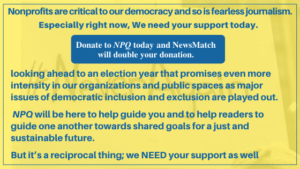
This letter is meant to give you a peek into NPQ’s backroom, and it is written by NPQ’s senior managing editor, who knows a lot about how stories are crafted here. It interrupts the four-part series we have been running on critical philanthropic trends, and we print it here to remind you of the importance of supporting NPQ’s work. In this piece, Cassandra Heliczer describes how NPQ does investigative journalism, and why it works.
There is at this moment an important story gaining momentum in mainstream U.S. news: the mystery of the disappearing small and midsize donor.
This disturbing trend in individual giving is one first surfaced by the Nonprofit Quarterly, in partnership with Dr. Patrick Rooney of the Indiana University Lilly Family School of Philanthropy, in fall 2018. During NPQ’s ongoing conversation with Dr. Rooney, the question about whether the rise in megadonations was accompanied by other changes in other categories of donors came up, and he graciously went looking for the story behind the story.
This is NPQ’s version of investigative journalism, which is highly collaborative and grounded. We can and do go about things differently because we are small but blessed with many partners who help us to identify important questions and then dig down in a disciplined way to get the story behind the story.
Most concerns about the new landscape of journalism have been around the decline of “trustworthy,” independent, and deep/investigative reporting; but there is another factor to be concerned about. Nonprofit sites like NPQ report in/from the environment, while mainstream media reports on/about it. The distinction is significant: there are things native to where the news is coming from that will only be visible to a grassroots eye—patterns that become discernable over time, seemingly disparate trends in what are largely seen as separate contexts that turn out to crosscut or relate in less obvious ways, and other less-than-obvious details.
Sign up for our free newsletters
Subscribe to NPQ's newsletters to have our top stories delivered directly to your inbox.
By signing up, you agree to our privacy policy and terms of use, and to receive messages from NPQ and our partners.
Such facets are like the tesserae of a mosaic, each one of which is needed for the full scene to reveal itself.
That is what NPQ does every day with you as our community helping us to reflect the complexities of the world in which we work…in which we are trying to make change.
This kind of nonprofit investigative work that surfaces trends, along with their submerged threads or crosscurrents, often goes unrecognized until the story is picked up by mainstream media—and all too often, the original researchers and writers disappear, uncredited, along with their original work. These are the people who care, and who take the time and make the effort to answer our questions and make the connections. They are who give NPQ’s work the richness our readers have come to depend upon over our twenty years of publishing.
So we take this moment to thank our big community of research partners.
And please donate today to preserve informed reporting on this essential civil sector. Without it and without journalism, a true democracy would cease to exist, and NPQ is at that nexus—always working for you.














